![]() Squash has the ability to be one of the most frantic and frenetic racquet sports around, thanks in no small part to the fact that it is played in a relatively small four-walled court. Governed by the World Squash Federation and recognised by the International Olympic Committee even though it’s not actually part of the Olympic Games, squash can be played by both single opponents and doubles partnerships like many other racquet sports.
Squash has the ability to be one of the most frantic and frenetic racquet sports around, thanks in no small part to the fact that it is played in a relatively small four-walled court. Governed by the World Squash Federation and recognised by the International Olympic Committee even though it’s not actually part of the Olympic Games, squash can be played by both single opponents and doubles partnerships like many other racquet sports.
Despite its fast-paced nature and the fact that it can seem like a really difficult sport to the uninitiated, squash actually allows players of any level to play it thanks to the use of different balls. Those with a blue dot on them travel quickly and have a high bounce, giving players time to adjust their body position and so on to be able to hit it. There are a range of balls all the way to double yellow ones that are much slow and bounce lower, generally being reserved for extremely experienced players.
Best Bookmaker For Squash
Bet365

Squash is one of the more difficult sports to bet on as there are no bookies that provide year round markets.
This makes it tough to know who you need to have an account with to place squash bets. Generally speaking you will need to look at the big 5 or 6 sites to find markets.
When markets do become available closer to the bigger events you won't do better than Bet365 for both depth and value. If you are looking to compare odds with someone consider the bigger brands as other options.
Betting On Squash
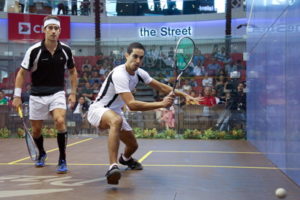 There are numerous different markets you can bet on for squash matches, if you can find a bookmaker that will cover the tournaments in detail. The main markets to look out for are as follows:
There are numerous different markets you can bet on for squash matches, if you can find a bookmaker that will cover the tournaments in detail. The main markets to look out for are as follows:
- Match Betting on the winner of an individual match
- Tournament Betting on the overall winner of a competition
- Point Betting is normally available on in-play matches
- Correct Score betting can be found on some markets
- Winning Margin involves figuring out how many points a player will win by
The History Of Squash
Origins In The Game Of Fives
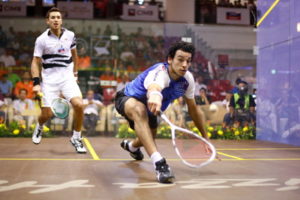 Despite being a game that involves the use of a racquet, squash’s history can actually be traced back to the days of played ‘fives’ with a closed fist or an outstretched hand. In the mid-12th century the French developed a game called jeu le paume, which gradually developed into the sport that we know as tennis today.
Despite being a game that involves the use of a racquet, squash’s history can actually be traced back to the days of played ‘fives’ with a closed fist or an outstretched hand. In the mid-12th century the French developed a game called jeu le paume, which gradually developed into the sport that we know as tennis today.
The sport changed over the years, mainly because of the introduction of sticks to ‘extend’ the reach of the player. By the end of the 15th century the Dutch had created racquets and the game became more formalised, moving into purpose-built courts.
Prinsoners Invent ‘Racquets’
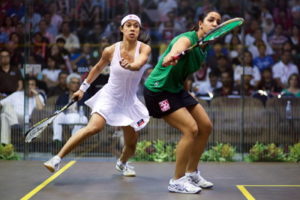 As the game developed, so did the desire to play it outdoors. It became the national sport of countries throughout Europe and by 1600 the city of Paris alone boasted around 250 courts. In Britain it became one of the most popular sports around, particularly loved by the Tudor kings of the time.
As the game developed, so did the desire to play it outdoors. It became the national sport of countries throughout Europe and by 1600 the city of Paris alone boasted around 250 courts. In Britain it became one of the most popular sports around, particularly loved by the Tudor kings of the time.
Real tennis gradually developed into tennis as we know it, with lawn tennis being invented in 1873. The sport’s popularity meant that it was played by anyone who was interested in being competitive, which in the early part of the 18th century included prisoners at a debtors jail in London.
The prisoners couldn’t play real tennis in its true for, so instead they developed a version of it that required players to hit a ball against one or two of the walls in the prison. The game was given the name ‘racquets’ and the ball was made up of wound cloth. The lack of such material in the prison meant that the ball was significantly smaller than those used in real tennis, more like the size of a golf ball.
The racquet used, meanwhile, was a stretched out tennis racquet. The game soon began to move out of the prison and onto the streets, with workingmen playing it in the yards of their taverns and school children playing in their playgrounds.
Racquets Begins To Spread
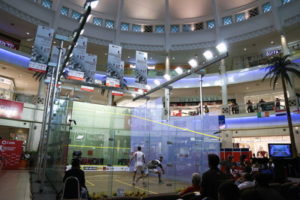 As the game became more popular, so too did the necessity to have courts to play the game in. They began to spread around the United Kingdom, mainly made up of roofless areas with a couple of stone walls on a paved stone floor.
As the game became more popular, so too did the necessity to have courts to play the game in. They began to spread around the United Kingdom, mainly made up of roofless areas with a couple of stone walls on a paved stone floor.
The weather in Britain has never been favourable for outdoor games, of course, so soon there was a desire to find courts that had a fixed roof. In 1830 the Royal Artillery built a covered court for racquet play at the Woolwich armoury, whilst the Marylebone Cricket Club decided to follow suit in 1844 and built one next to the real tennis courts that they’d had installed at Lords.
Meanwhile, the game had already begun to spread around the rest of the world thanks to the ever-expanding nature of the British Empire. Canada got a covered racquets court in the 1770s, with India following suit in 1821 and Australia in 1847. During the same period that racquets was moving around the globe, public schoolboys were developing a game of their own that was similar in nature to the original French game of jeu le palme.
Fives was similar to racquets but didn’t require the use of a racquet, making it more popular for those that needed to be able to play the game easily and quickly. Much like racquets, this game also begin to spread around the world.
Squash Begins To Take Shape
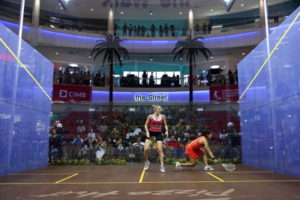 At Rugby School, where the game of rugby was believed to have started, there was a court for fives that was 28 feet by 18 feet in size and that had side walls that sloped down towards the back. On the front wall, where the ball was aimed, was a line of tin that sat 2 and a half foot from the floor.
At Rugby School, where the game of rugby was believed to have started, there was a court for fives that was 28 feet by 18 feet in size and that had side walls that sloped down towards the back. On the front wall, where the ball was aimed, was a line of tin that sat 2 and a half foot from the floor.
Meanwhile, at a rival public school called Harrow, pupils realised that a racket ball with a puncture in it would be far more likely to ‘squash’ against the wall when it struck it, meaning that players were far more likely to be tested by the shots that they had to face.
In 1845 vulcanised rubber was patented, meaning that players could play with balls made of rubber and decide how much air should be put into them. The students at Harrow began to play a game that had shared tendencies of racquets and fives, which earned the name ‘baby racquets’.
In 1865 the school opened a new area that boasts courts for both racquets and fives, with the former being popular but the latter struggling for an audience. Soon the boys began to play their relatively new sport of baby racquets on the fives courts, capturing the imagination of those that played and enjoyed the fast-paced nature of it as well as the gladiatorial combat involved in the one-to-one battle.
Squash Begins To Spread
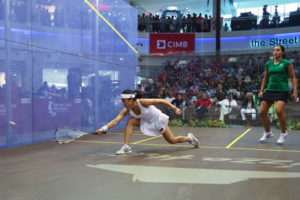 When the Harrow boys went home for the holidays they began to take the new game with them, introducing it to friends from different schools. Likewise graduates from the school began to build their own courts, with the first purpose-built one being created by a former student called Vernon Harcourt in his home in Oxford out of wood.
When the Harrow boys went home for the holidays they began to take the new game with them, introducing it to friends from different schools. Likewise graduates from the school began to build their own courts, with the first purpose-built one being created by a former student called Vernon Harcourt in his home in Oxford out of wood.
Soon the different public schools began to see the game being played in their own fives courts, leading to the game gaining its own sense of being as a result. In 1890 Lord’s erected a pavilion and created a court for squash as part of it. Bath Club added its own courts in 1894 and Queen’s Club built two courts of its own in 1905.
As with any burgeoning sport, the game didn’t have a specific set of rules and the courts used around the country varied wildly. In the wake of the First World War, the Bath Club launched the Bath Club Cup, which was intended to be a league competition for London clubs but struggled because it saw the use of six different court sizes and five different ball types.
This in spite of the fact that the Tennis, Rackets & Fives Association of Queen’s Club had taken squash on as a sub-committee sport in 1907 and had issued rules in 1909. Even then the court used was down to club rules and two different ball types were recommended. Indeed, the sub-committee’s rules specifically said that there should be ‘flexibility’ in how the game was played.
The Rules Are Agreed
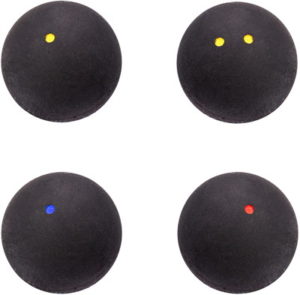 In 1923 the Royal Automobile Club held a meeting in which the rules for squash were discussed. Those in attendance were members of clubs that played squash regularly and the hope was that an agreement on a standardised set of rules could be reached. They formed the Squash Rackets Representative Committee and of the half a dozen or so different ball types that were presented to them they chose the slowest as the standard ball to be used.
In 1923 the Royal Automobile Club held a meeting in which the rules for squash were discussed. Those in attendance were members of clubs that played squash regularly and the hope was that an agreement on a standardised set of rules could be reached. They formed the Squash Rackets Representative Committee and of the half a dozen or so different ball types that were presented to them they chose the slowest as the standard ball to be used.
There was also consensus on the Bath Club’s court, which was 32 foot by 21 foot in size, being selected as the court size that would be considered to be the standard one for English players.
The Squash Rackets Association was formed in 1928 with the expressed aim of running the sport of squash in Great Britain. The first decision that they took was to slow the ball down even further, with the original ball chosen having been declared to be too fast and too large.
Over the six years or so that followed the Association gradually slowed the ball down further and further. At the same time the rules began to be developed so that they moved away from the point-per-rally system that saw games last until 15 points had been scored. In 1926 the current hand-in, hand-out version of scoring to 9 points was introduced and it’s been place since.
Rules and How Squash Is Played
Now that we know a bit more about the history of squash it’s important to have a look at how the game is played. The first thing to do is to explore the court itself.
The Squash Court
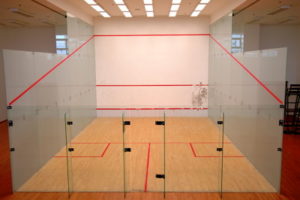 Squash Courts have four walls, with the front one being the most important surface as that’s the one that players are required to hit the ball with. There are three parallel lines marked on it, one slightly up form the floor, one in the middle and one at the top. The top line then tracks along the side walls and downwards to the back wall.
Squash Courts have four walls, with the front one being the most important surface as that’s the one that players are required to hit the ball with. There are three parallel lines marked on it, one slightly up form the floor, one in the middle and one at the top. The top line then tracks along the side walls and downwards to the back wall.
A shot that is stuck outside of the top line or underneath the bottom line is out, whilst the middle line is only relevant during services and is irrelevant during the rest of the game. On the floor of the court there is a line roughly in the middle, with a box on either side of it and a line reaching out from the line to the back of the court.
Game Play
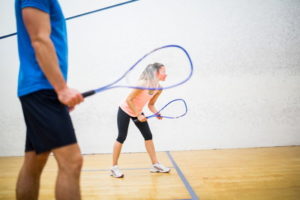 The service requires players to stand in the box on their side of the court and hit the line to the other side by striking it off the wall above the service line. The receiver can choose to volley the ball if they wish and if they win they take the serve. If the server wins then the players swap sides and the next point begins.
The service requires players to stand in the box on their side of the court and hit the line to the other side by striking it off the wall above the service line. The receiver can choose to volley the ball if they wish and if they win they take the serve. If the server wins then the players swap sides and the next point begins.
Once the ball is in-play the two players in singles games take turns hutting the ball, with the requirement being that it must hit the front wall before it touches the floor, even if this involves it being hit off the side or back walls first. The ball cannot hit the floor before the front wall after it has been hit by the racquet and it also needs to strike the wall below the top line and above the bottom one.
The ball can strike the floor once before the returning player hits the ball. There are also rules about obstruction, with players needing to be careful not to deliberately obstruct their opponents. Even accidental obstruction can lead to let being given or a point being given. In general, players attempt to return to the centre of the court after playing each shot.
How The Game Is Scored
 There are different scoring systems at play depending on where you play and what the pre-agreed rules are. The majority of clubs in the UK will use the English hand-in, hand-out system that is a first to 9 points game in which only the server can score a point. If it reaches 8-all then the first player to get there can decided whether to play to 9 or 10 points.
There are different scoring systems at play depending on where you play and what the pre-agreed rules are. The majority of clubs in the UK will use the English hand-in, hand-out system that is a first to 9 points game in which only the server can score a point. If it reaches 8-all then the first player to get there can decided whether to play to 9 or 10 points.
In terms of the scoring system used for professional squash matches, the official version is the points-per-rally one. In this, whoever wins the rally gets a point regardless of whether they served or not. Games in this version are played to 11 and the winner needs to win by two clear points, so if the score reaches 10-10 then they must get to 12-10 to win.
The Americans tend to use a similar system to the points-per-rally variation with the difference being that they play to 15 points. In recent times another scoring system known as RAM has emerged. In this version players compete in a best-of-5 games set, with each game lasting for 3 minutes of the ball being in-play. Downtime isn’t counted so the clock stops when the ball goes out of play. It’s a complicated system of play that is unlikely to catch on in the amateur game.
The Biggest Tournaments
| Tournament | Details |
|---|---|
| World Squash Championships | Founded in 1976 and with the women’s game being added in 1979, the World Squash Championships is an annual event that is part of the PSA World Series |
| British Open Squash Championships | The oldest squash tournament in existence, this has been taking place since 1930, with the professional side of the women’s game being added in 1974. It was considered to be the de facto world championship until the actual world championships began |
| Squash at the World Games | Squash has been part of the World Games since its inauguration as a competition in 1997. The event takes place every four years |
| WSF World Team Squash Championships | Organised by the World Squash Federation, this tournament is played between teams representing different nations. Teams of 3 or 4 players play singles matches against each other and the event occurs every 2 years |
